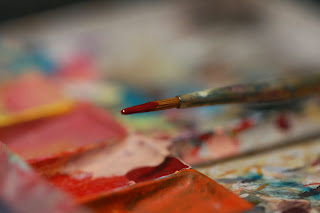One technique I had learned over the years is to paint with thin paint, very very thin paint. Some call it glazing, by applying layer and layer of thin paints to an area the thickness of paint could be much easily controlled.
My recent favorite is the Formula P3 mixing medium. But first, let's see what do I mean by 'thin'
The paint we use is GW Scab Red Paint
This what the paint looks like straight out of the paint pot
Even after getting rid of the excess paint on the brush by brushing it off the edge of the palette, the paint is still pretty thick. I measure the thickness by brushing it on the board, see if the markings would shown through. As shown here the lines kind of show up through the paint, but only barely.
So what I used to do is to use water to thin the paint, that's what a lot of people do actually, but I was never really good at doing that. The problem with water is the paint seems to go the the edges of the area I painted. So here you can see that although the blue lines are showing through the paints are not so even.
One trick I learned is to remove excess paint on a piece of dry tissue. but as show here the water thinned paint actually spread out pretty widely and therefore 'pulled' the paint to the edges.
And sure enough the same 'edging' effect happened even if I carry less paint on the brush.
This is what the mixing medium looks like, it looks a bit like white glue. Here I had already added thinned the medium with 50% water, mostly to prevent it from drying and to make it easier to manage.
See this is how good the medium is, it doesn't spread out like water thinned paint, and no more edging.
See how thin it is? the paint becomes more like a glaze or a tint to the board.
My recent favorite is the Formula P3 mixing medium. But first, let's see what do I mean by 'thin'
The paint we use is GW Scab Red Paint
This what the paint looks like straight out of the paint pot
Even after getting rid of the excess paint on the brush by brushing it off the edge of the palette, the paint is still pretty thick. I measure the thickness by brushing it on the board, see if the markings would shown through. As shown here the lines kind of show up through the paint, but only barely.
So what I used to do is to use water to thin the paint, that's what a lot of people do actually, but I was never really good at doing that. The problem with water is the paint seems to go the the edges of the area I painted. So here you can see that although the blue lines are showing through the paints are not so even.
One trick I learned is to remove excess paint on a piece of dry tissue. but as show here the water thinned paint actually spread out pretty widely and therefore 'pulled' the paint to the edges.
And sure enough the same 'edging' effect happened even if I carry less paint on the brush.
This is what the mixing medium looks like, it looks a bit like white glue. Here I had already added thinned the medium with 50% water, mostly to prevent it from drying and to make it easier to manage.
See this is how good the medium is, it doesn't spread out like water thinned paint, and no more edging.
See how thin it is? the paint becomes more like a glaze or a tint to the board.










